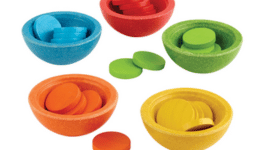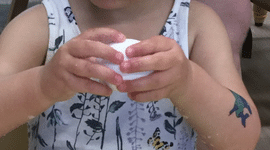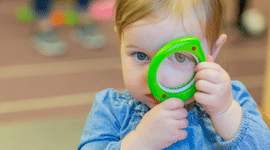Encourage Spontaneous Language in Toddlers
How do toddlers communicate with you? Do they use gestures, eye contact, sounds, or words? Do they rely on you to know what they want? How can we encourage toddlers to be more verbal and initiate communication?
Parents, caregivers, and educators often ask children questions or model words for imitation, which automatically sets children up to be “responders.” In the toddler classroom, communicative temptations teach children to be initiators of communication and encourage them to communicate in some way spontaneously.
What are communicative temptations?
Communicative temptations are situations constructed to “tempt” or motivate a young child to initiate some form of communication – verbal, nonverbal, or gesture – to obtain what they desire or express something undesirable. Communicative temptations also encourage social interaction and build early language skills.
-
Easy Steps to Tempt Toddlers to Initiate Communication
Find an activity, object, or toy that a child finds irresistible! Activities that work well are those that are easily stopped and started (e.g., bubbles, swing), or an object that has multiple parts and pieces that you can hand to a child one at a time (e.g., tracks for a train track, blocks for a tower, pieces to a puzzle, etc.) The key is to be able to have control of the multiple pieces!
- I love these fun, colorful sensory blocks and use them daily in my therapeutic practice.
- Big bubble wands are a must.
- An example of an activity with multiple pieces that help create endless communicative opportunities.
Start the activity. Engage with the child and show them how much fun it is, especially with you as the facilitator! After a few seconds, stop! Put the lid on the bubbles or the wand back in the container. Stop the swing suddenly and hold it back from swinging. Give them only one train track, one block, one puzzle piece, etc.
WAIT! Never underestimate “the power of the pause.” Give children a chance to communicate to you, instead of anticipating what we know they want next. Ideally, we want them to communicate without our help (we want them to initiate the communication), so pausing and waiting encourages them or signals to them to act next. What does the child do? Look expectantly and excitedly at them, as if you are waiting for them to do something first - which of course, we are!
When children communicate with you, it may be verbally or nonverbally, depending on their development and skill level:
- If a child isn’t using words yet, wait until they do something, ANYTHING, to indicate that they want more (e.g., they might move their body in anticipation, point, reach, laugh, smile, give a picture or symbol, make eye contact with you rather than the object/toy that they want).
- If a child vocalizes to indicate what they want but is not yet saying the word, say the name of the item for them, waiting a few more seconds, and then give them what they want.
- If a child imitates your words but is not yet saying them on their own, try waiting even longer before saying the word for what they want. Wait for one second, then say the word; repeat the activity and then wait for two seconds before saying the word; repeat, wait for 3 seconds before saying the word, and so on. Silence is OK and may further motivate your child. If your child gets frustrated, go back to waiting a shorter amount of time, maybe give the initial sound of the word and pause (e.g. “ba…” for bubbles), and then gradually build up the wait time.
- Offer lots of praise and social reinforcement (e.g., clapping, cheering “yay!”, tickles, etc.), after the child initiates their form of communication.
Activities That Promote Spontaneous Language Opportunities
Place a favorite toy out of the child’s reach and wait.
Place a favorite toy in a clear container that your child cannot open while your child is watching, then put it in front of the child and wait.
Give the child only part of the materials needed for an activity and wait while holding missing objects out of reach (e.g., paper without crayons, a puzzle without pieces, etc.)
- Using a highly motivating toy, such as the Spin Again, will likely leave the child wanting more. You can easily control the other pieces and parts by hiding them behind your back or enticing them by putting the next piece on your head as you wait for the child to initiate. The colorful spinning rings offer a visual sensory experience that most toddlers love!
- Knob puzzles are also great to use.
Activate a wind-up toy, let it deactivate, and then hand the toy to the child.
Blow up a balloon and have it slowly deflate, then give the deflated balloon to the child or hold the deflated balloon up to your mouth and wait. CAUTION: Please keep in mind that an adult must carefully supervise any activity with a balloon.
Sing a favorite song with the child, or read a favorite book; before you say the last word in the line, pause and wait.
-Brown Bear, Brown Bear, What Do You See? is one of my all-time favorites! There are many repeated phrases and words, and toddlers often anticipate each line when they learn it. Additionally, the book targets early sentence structure and descriptive vocabulary.
Engage the child in anticipatory play (e.g., “I’m gonna get you…” with tickles; “Peek-a-Boo!”), then look at the child and wait.
The best thing you can do to help increase toddlers’ spontaneous language is to be an animated, fun, and social play partners. A child is more likely to initiate interactions if they are socially motivated. Don’t be afraid to be silly or exaggerated. Remember always to wait and give the child that opportunity to start communication and acknowledge the communication they DO use (e.g., eye contact, turning their body or face towards you, reaching, gesturing, vocalizing, approximating sounds or words). The more opportunities we can provide throughout the day, the more we can promote spontaneous social interactions and build upon toddlers’ early language skills.
About the Author
Samantha Hom is a Speech and Language Pathologist specializing in Early Intervention (birth-3 years) and toddlers newly diagnosed with Autism Spectrum Disorder and their families. She is passionate about empowering families and giving them the confidence, they need to connect and engage with their child. Samantha lives in New York City and holds a Certificate of Clinical Competency in speech language pathology from the American Speech and Hearing Association, and New York State licensure in speech language pathology. In addition to providing 1:1 speech and language therapy, she also leads an early social skills group at a pediatric clinic, focusing on early play and social skills. During these unprecedented times, Samantha is now navigating the waters of Teletherapy, and collaborating with families and caregivers more than ever.
Inspiration for Infants & Toddlers
Click on a blog article below for inspirational resources!



